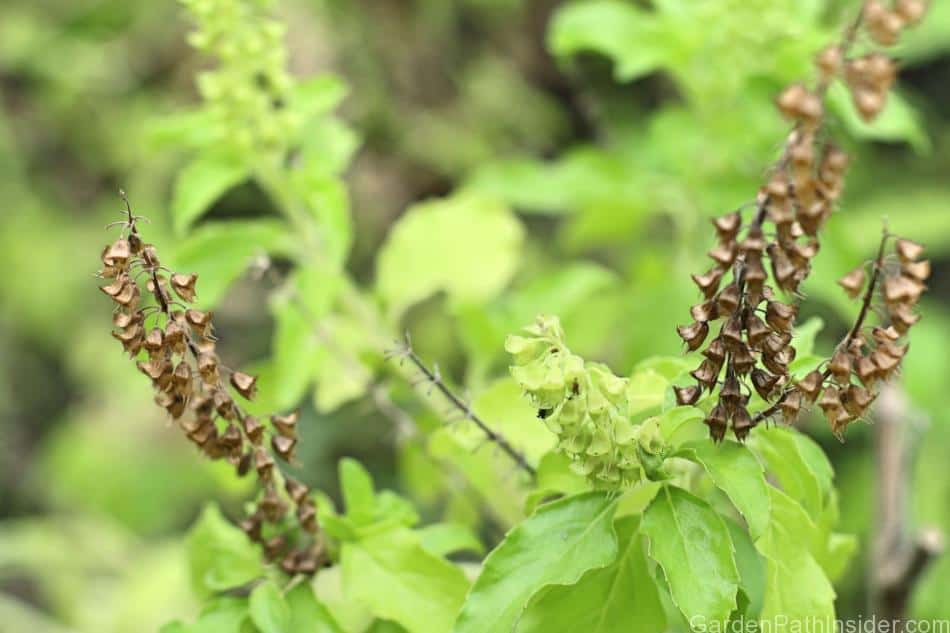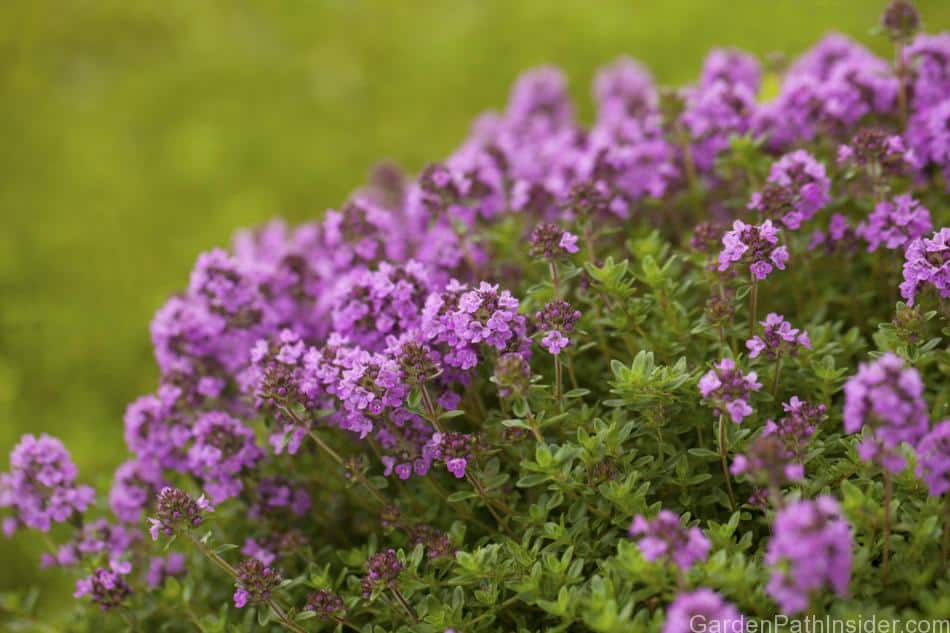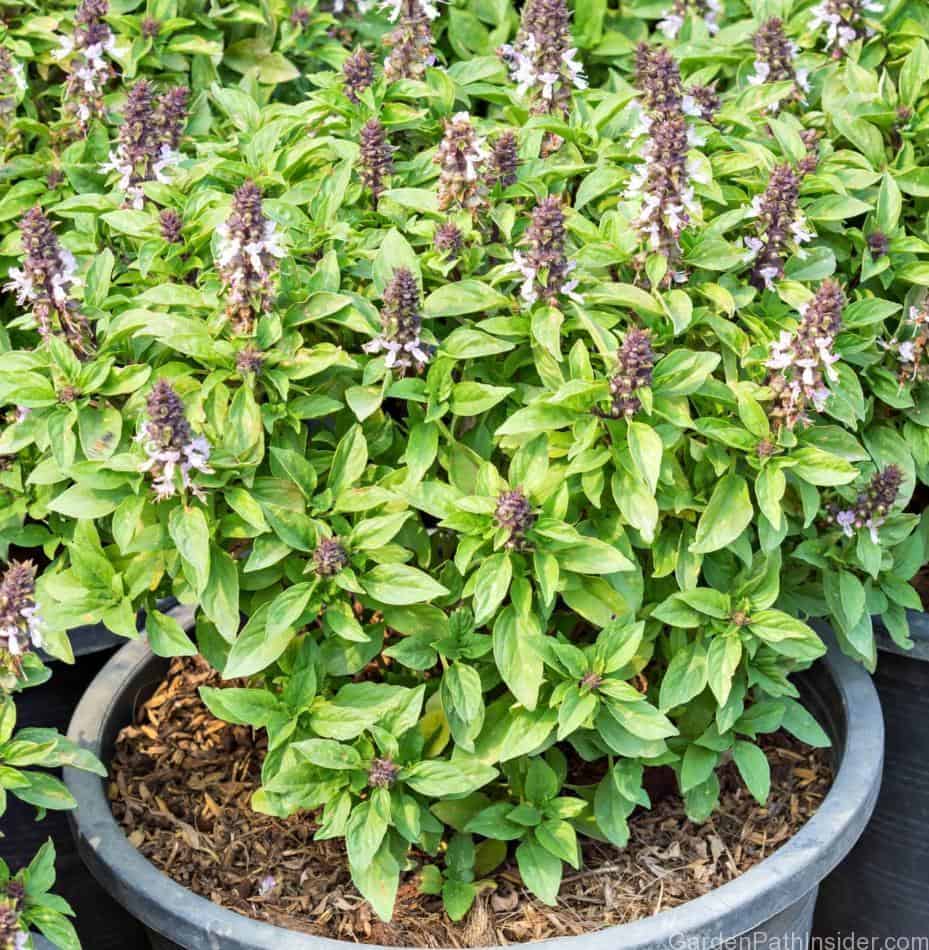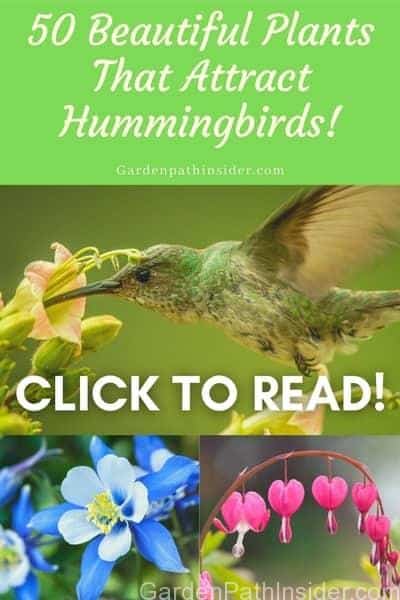
Fresh basil and thyme are excellent herbs to add to your garden as companion plants. When grown in the correct conditions, basil and thyme produce abundant amounts of flavorful leaves that are enjoyed in many culinary dishes.
Basil and thyme should not be planted together in the same container or garden bed, as thyme requires drier sandy soil and basil requires moist fertile soil. Basil and thyme are great companion plants when grown side by side in separate containers, as thyme repels pest insects that may damage basil.
Growing basil and thyme together is an excellent introduction to companion gardening. Both herbs can be grown in your kitchen year-round with minimal materials and the right growing conditions!
Basil and Thyme Companion Planting
Basil and thyme are companion plants that thrive when grown side by side. Thyme is a perennial with flavorful leaves that are used in savory dishes, while basil is an annual (or perennial in warmer climates) with sweet crisp leaves often used in salads, pasta, and as pizza toppings.
Basil and thyme require different growing conditions for soil nutrients and water needs, though both require full sun of 6 to 8 hours for optimal growth. We will cover these growing conditions below.
Basil and thyme should not be planted in the same container due to their different water and soil needs. In larger garden beds these plants can be added to different locations as long as the soil needs are met for each. During the intense summer heat, basil plants may need to be watered several times per day.
Basil grows in clusters that can spread through its growing space during the season. Thyme is native to the Mediterranean and is available in several different varieties that greatly vary from one another.
If you are planting basil and thyme in the same growing space, it is best to plant about 8 to 12 inches apart (20.32 cm 50.8 CM) in a very well-draining area. This will give each plant’s roots enough space to spread and develop while allowing the thymes root ball to stay dry and separate from the basil.
Related article: Can Basil and Rosemary Be Planted Together?
Are you planting a kitchen herb garden? See our article resource on growing rosemary as a companion plant to basil. Rosemary is a wonderful herb that can be added to savory dishes like, chicken, pasta, and even topped on pizza.
Read more here: Can Basil and Rosemary Be Planted Together?
Cover image details: Pink Wild Thyme with bee_© Diyana Dimitrova/123rf.com

Basil Varieties
Basil is an annual plant with large tender leaves and a sweet flavor. Basil is used in many dishes, from pizza and salads to savory pasta.
Basil grows about 36 inches tall (91cm) and blooms small flowers during the spring and summer.
Basil requires day-time temperatures around 60°F to 70°F (15°C to 21°C) and night-time temperatures around 45°F to 50°F (7°C to 10°C).
Basil is not a hardy plant and will not survive frosts or cold temperatures. Basil spreads slightly as it grows, though this plant will not take over a garden with the same speed as mint.
There are several species of basil, each having different flavor notes and fragrances. It is recommended to grow a single species of basil per pot or garden bed. Growing several varieties of basil together in close quarters may cause cross-pollination, where the different species will lose their individual characteristics of flavors and fragrances, and instead blend together.
Below are some of our favorite Basil species to use in the kitchen:
- Sweet basil (Ocimum basilicum)
- Cinnamon basil (Ocimum basilicum Cinnamon)
- Lemon basil (Ocimum x africanum)
Basil Summary
- Life Cyle: Annual / Perennial. Basil is a perennial in warmer climates with very mild winters, and an annual in cold climates with harsh winters.
- Height: About 36 inches tall (91cm)
- Sun Needs: Full Sun 6 to 8 hours per day
- Soil Needs: Moist nutrient-rich well-draining soil
- Water Needs: May require water daily, twice per day in extreme hot weather
- Bloom Time: Blooms small flowers during the spring and summer
Sweet basil has a refreshing taste and is often used on pizzas with mozzarella cheese, tomatoes, and a balsamic vinaigrette. Our container garden always includes at least one variety of tomato in addition to sweet basil.
If you are interested in expanding your container garden and would like to enjoy fresh produce year-round, read our article resource on growing tomatoes indoors year-round. In the article, we describe the path to a successful and fruitful indoor tomato garden.
Read more here: Can You Grow Tomatoes Indoors Year-Round?

Thyme Varieties
Thyme (Thymus vulgaris) is a flavorful herbaceous perennial that grows up to 12 inches tall (30cm). Thyme is used in savory culinary dishes; often paired with meats, fish, vegetables, and even cheeses.
Native to the Mediterranean, thyme thrives in fertile to sandy soils and full sun exposure. Thyme is a woody textured herb with several sub-varieties used for their culinary or ornamental properties. Each grows in different forms, from tall bush-like varieties to a variety that grows low and spreads efficiently often used as ground cover.
Varieties of Thyme include:
Creeping pink thyme (Thymus serpyllum): is a perennial ground cover variety of thyme with pink to purple flowers. This thyme grows up to 3 inches (7cm) in high. Creeping pink thyme requires full sun and is efficient at conserving water, making this variety perfect for drier sandy soils.
English thyme (Thymus vulgaris): English thyme is a culinary variety of thyme with pink fragrant flowers and deep green leaves. English thyme grows up to 12 inches (30cm) tall with pink flowers and dark green leaves. English thyme does best in full sun with well-draining soil as thyme requires drier sandy soils to thrive.
Lemon thyme (Thymus x citriodorus): Lemon thyme is a culinary variety of thyme that is low maintenance and resistant to deer and drought. Lemon thyme requires full sun and blooms in mid-summer, growing up to 12 inches (30cm) tall with up to 24 inches (60cm) in spread. Lemon thyme thrives in dry sandy soil.
Thyme Summary
- Life Cycles: Perennial
- Height: Up to 12 inches tall (30cm)
- Sun: Full Sun optimal, partial sun is still acceptable
- Soil: Can grow in rocky-sandy soil, does best in drier fertile soil
- Water: Requires drier soil, add water slowly, and let the water absorb fully to avoid overwatering.
- Bloom Time: Summer to early Fall
Growing Requirements for Basil and Thyme
Basil: Container and Garden Bed Requirements
Basil can be easily grown in container gardens or garden beds. Basil will spread throughout its growing space during the season and provide multiple harvests each year. Basil does not require extremely large containers or pots to thrive.
Basil does best in smaller pots that hold less soil, as too much soil can retain excess water and drown the basil roots. A single basil plant will grow best in a pot that is 6 to 8 inches in diameter (15cm to 20cm), and 6 to 8 inches deep (15cm to 20cm).
Thyme: Container and Garden Bed Requirements
Thyme can thrive in any size container. The thyme plant will grow to a height of up to 12 inches tall (30cm) depending on the variety you choose.
A container or pot that is at least 6 to 8 inches in diameter (15cm to 20cm), and 6 to 8 inches deep (15cm to 20cm) will be perfect for any variety of thyme you choose to grow.
Basil and thyme are great companion plants when grown next to each other in separate containers or different garden beds. Both basil and thyme have varieties that range in size, leaf texture, and flavor.
Once you have identified the variety to grow, pick the corresponding sized container. There are many styles of plastic growing containers and clay pots to choose from. The main feature to look for when selecting a container or pot is adequate drainage.
Clay pots are my first choice for container gardening, as they are porous and will allow better drainage of water through the porous clay material.
Plastic growing containers have their advantages as there is more variety in their shapes and styles and they are often less expensive. If you have a container without drainage holes, then you may need to drill out a few yourself.
Once you have holes in the bottom of your pots, add permeable material into the bottom of the pot to allow excess water to drain. Use a few bits of broken clay pots or small rocks to keep the soil or roots from blocking the drainage ports. Adding a clay dish under the pot will contain any excess water and allow the plant to reabsorb the water as needed.

Soil Needs for Basil and Thyme
Basil requires moist nutrient-rich, well-draining soil. The soil should be loose enough to let the small roots easily spread as the plant grows. Avoid using topsoil from your backyard, as it can be too compact and dense for potted plants.
Compost is also a great source of nutrients for basil and thyme, though it is not required for a healthy garden. Mix equal parts compost and potting soil for a great fertile growing medium for both plants. Store-bought potting soil works great for all container gardens.
Sterile potting mix is always recommended for container gardens, as backyard topsoil may contain bacteria or insects that could damage or contaminate your indoor container garden.
Thyme requires a drier growing environment and can thrive in sandy low nutrient soil. For a healthy thyme plant, I used store-bought nutrient-rich soil, and waterless frequently than basil.
Thyme is native to the Mediterranean and can thrive in the Mediterranean’s dry soils while getting its water from the rain and mist of the sea breeze. However, thyme will grow better in nutrient-rich well-draining potting soil.
Basil and thyme planted in an outdoor garden bed can be planted directly in well-draining aerated topsoil. For healthy outdoor plants, I fertilize each season with an organic fertilizer. Always follow the instructions on fertilizers, as too much fertilizer can damage the garden.
Water Needs for Basil and Thyme
Morning and evening are the best times to water your garden as the temperatures are cooler and there is minimal water loss due to evaporation. High noon is the least ideal time to water plants as the heat from the sun quickly evaporates the water.
Before watering your plants make sure to test the soil moisture to avoid overwatering. Press your finger in the soil a few inches away from the root system, being careful not to press too deep or damage the roots. Water thoroughly when the soil is dry to the touch. Too much water in the soil can cause the roots to rot and the plants will die.
Basil requires moist soil and frequent watering. Check water levels daily and water as needed. During extreme heat check the soil moisture in the morning and evening, and water twice a day if needed. Basil is sensitive to drought, and the leaves will begin to shrivel as soon as the plant becomes dehydrated.
Pro Tip: Before you harvest basil make sure the plant has been watered thoroughly. Leaves on a well-watered basil plant will be plump, crisp, and tender; while leaves in a thirsty basil plant will be wilted, soft, and stringy.
Thyme requires and thrives in slightly drier sandy soil. The sandy soil will help maintain a limited moister environment for the plant.
Signs of dehydration in basil and thyme. When basil and thyme are dehydrated, the new growth on the tops of each branch will begin drooping over sideways. Additionally, the soil will begin to pull away from the sides of the pot.
Dehydrated basil leaves will look very dry and brittle. When you see these signs, it is time to water your plants.
Watering potted basil and thyme. When watering potted basil and thyme, water until the soil is thoroughly saturated and water begins to drain out from the bottom of the pot. Stop watering once excess water begins to drain from the pot bottom to avoid overwatering.
Watering in-ground basil and thyme. Basil and thyme planted in-ground, are still susceptible to overwatering if the garden bed has poor drainage. Before watering, test the soil moisture content. Overwatering can cause the plants to become droopy and drown in standing water surrounding the roots.
If you have a backyard garden, consider investing in a soil moister sensing meter or a T-handle soil sampler probe. Both tools will give you an accurate reading of your garden’s moisture levels and could save you from overwatering some of the more fragile plants in the garden.
Light Needs for Basil and Thyme
Basil and thyme both require full sun of 6 to 8 hours per day, though both plants will grow with less than full sun. Maximum plant growth will require full sun.
In warmer climates, plant basil in a growing space that gets morning sun and afternoon shade during peak temperatures.
Basil and thyme grown indoors should be placed by a window that will get the full day’s sun (6 to 8 hours). Avoid placing your container garden near indoor heating elements like space heaters, ovens, or heating vents.
Basil is an annual and will die off during the cold months of the season. In warmer climates, basil can be perennial and may return the following season if the winter was not extremely harsh.

When Can You Harvest Basil and Thyme?
Harvest Basil
Basil leaves are best harvested once the plant has established its root system. Wait until the plant reaches about 6 inches tall (15cm) before taking leaves from the plant.
To increase the basil plant’s leaf density, pinch off the new growth at the top of the plant once the plant reaches 8 to 12 inches (20cm to 30cm). Nipping the new growth nods at the top of the plant will cause the plant to stop growing vertically and start to grow dense with more branches and leaves.
Pro tip: when harvesting leaves from basil and thyme use a pair of scissors to snip the leaves off as close to the stem as possible. This will avoid tearing or damaging the branches of the fragile plants during harvest.
Harvest Thyme
Thyme herbs are used as a flavoring in cooking. The leaves and stem are cut off the plant in sprigs and used fresh or dried; mostly in savory meals including meats, fish, vegetables, and even cheeses. Thyme leaves are most flavorful before it blooms.
To harvest thyme, choose a sprig on the plant that has not started to bud or bloom. Clip the sprig off the plant and rinse before use.
Fresh thyme can be stored in the refrigerator wrapped in paper towel. For longer storage, place thyme in a large zip-close bag, and store in the freezer for fresh herbs later.
Drying thyme is another way to preserve thyme. Clip thyme sprigs and hang upside down until fully dried, then store the dried thyme in glass spice jars.
Pro tip: When harvesting herbs, use a sharp pair of scissors to cleanly cut the stems at the node of each plant. This will help to avoid damaging the plant during harvest.
Thyme can be harvested at any time once the plant has established its roots.
Below is a quick view summary of both basil and thyme needs for your reference.
| Plant | Soil type | Water needs | Light needs | Bloom time | Harvest time |
| Basil | Loose well-draining fertile soil | Keep the soil slightly damp to moist. Water as needed. | Full sun | Summer | Basil leaves are edible at any time, though its best to wait until plants gets at least 6 inches tall (15cm). |
| Thyme | Sandy soil or well-draining fertile soil | Drought resistant and able to tolerate drier soils | Full sun | Summer, Fall | Thyme is ready for harvest from summer to fall. Though summer months are better to harvest the thyme at its peak |
Looking to expand your herb garden but you’re running out of space? We have a solution for you. Growing lavender in hanging baskets is a great way to introduce the fragrant herb into a garden of any size.
Our resource article will guide you on the best ways to incorporate and maintain hanging lavender into your garden. Read more here: Can You Grow Lavender in Hanging Baskets?
Next Read, Butterfly Garden!
Click the image below to read our article on 50 Beautiful Plants and Flowers to Attract Butterflies to Your Yard!
In this article, we provide beautiful images and fun ideas for gardens of any size. From window sill gardens to large backyard landscapes. Find the perfect flowers for your next Butterfly Garden! Click below to read!
Next Read, Hummingbird Garden!
Click the image below to read our article on 50 Beautiful Plants That Attract Hummingbirds to Your Yard!
In this article, we provide images of beautiful flowers to attract and support hummingbirds. There are plants for nearly every growing condition and garden size. Click the image below to learn fun new flowers that will bring these beautiful birds to your yard!
The sources below were used for additional research and clarification for this article:
Google.com
Wikipedia.com


